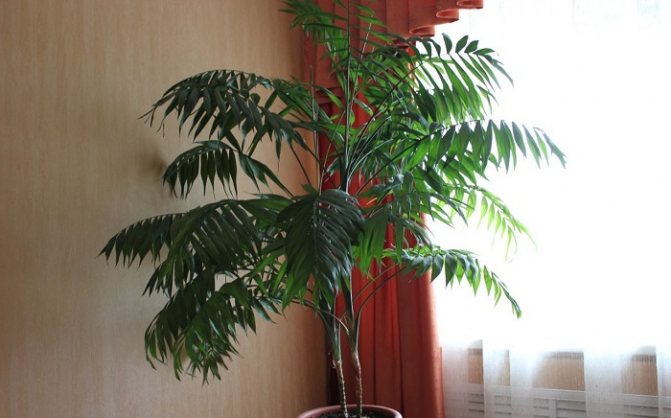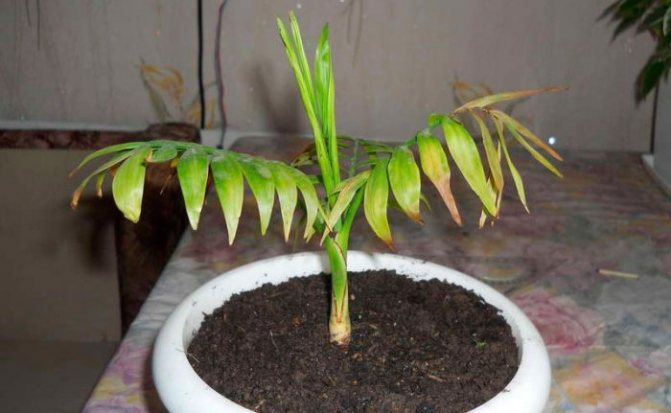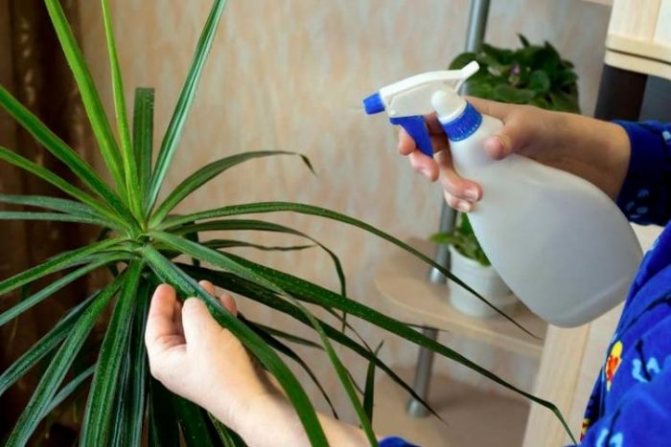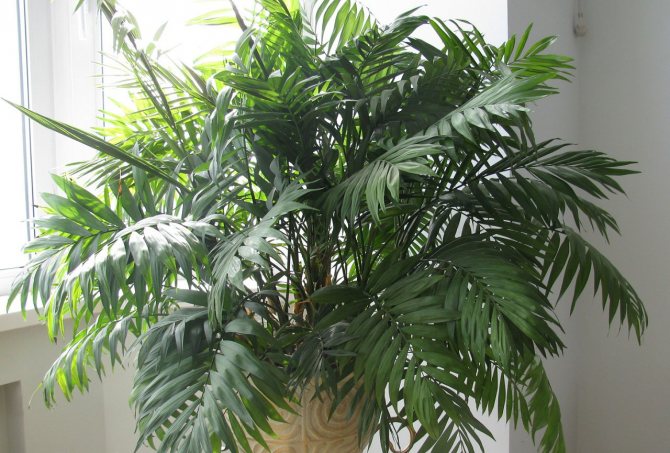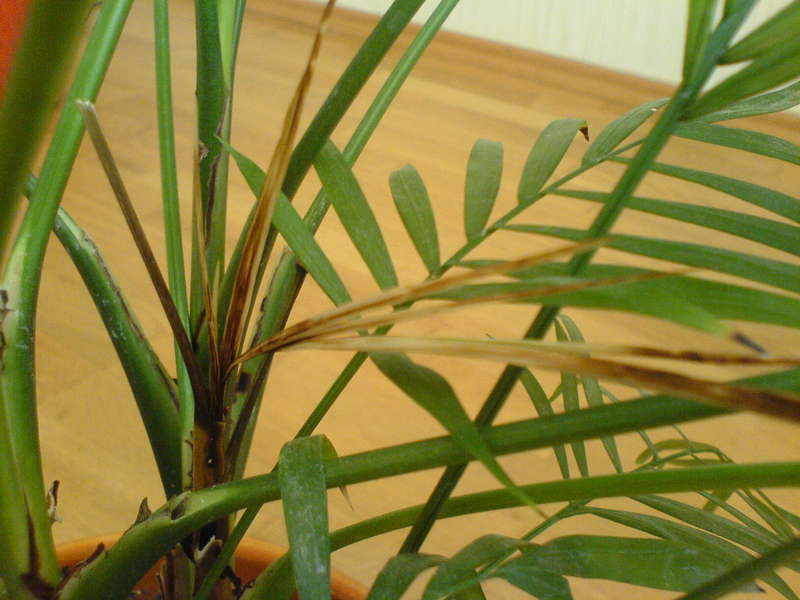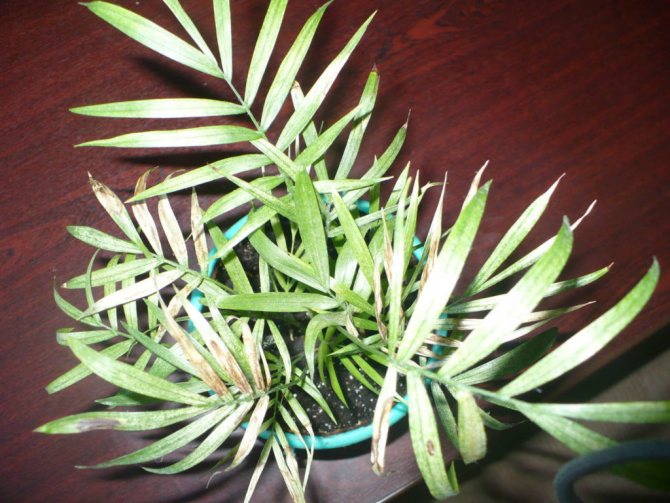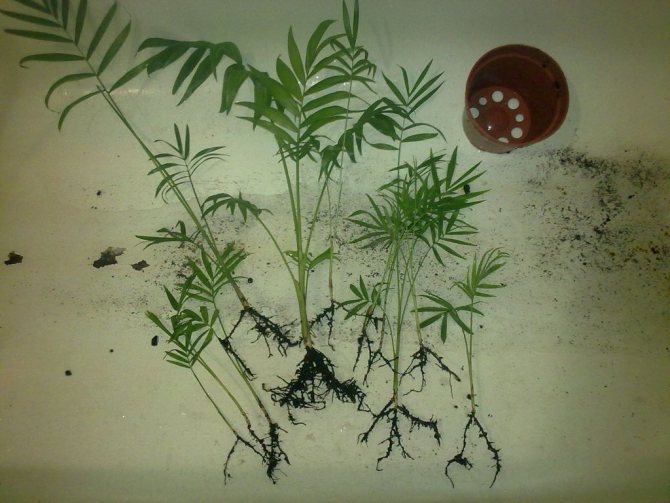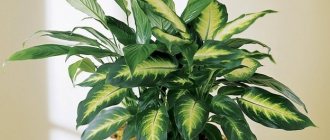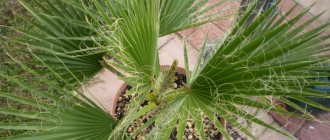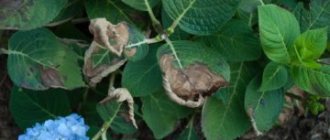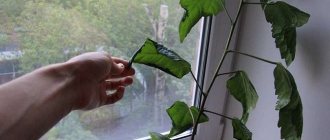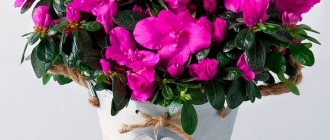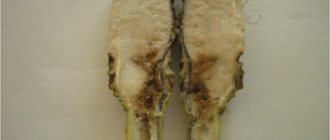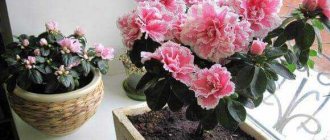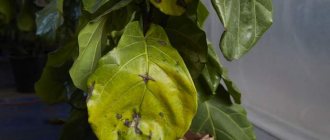Why do palm leaves dry: the main reasons
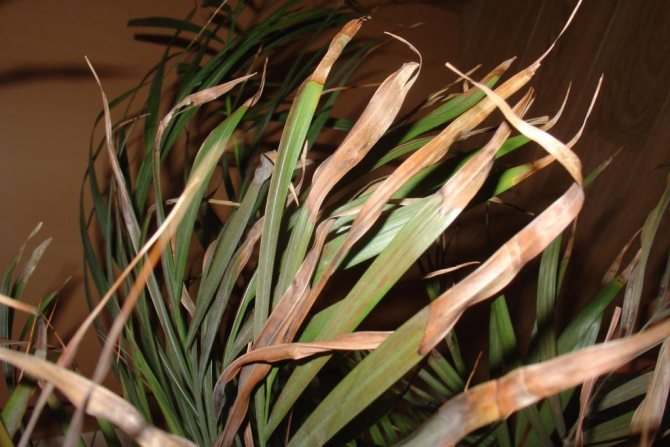
Although most indoor palms are true tropical plants, they do not tolerate heat, especially if the high temperatures are supplemented by the low humidity in the room.
The risk of leaf dryness at the tips is greatly increased during the heating season, when hot air currents rise from the radiators.
In addition to these factors, a palm tree can dry leaves in the following situations:
- Temperature changes or exposure to drafts;
- Frequent transplants unnecessarily;
- Disturbed watering (severe drying out or waterlogging of an earthen coma);
- Mineral starvation;
- Exposure to pests and consequences of diseases.
Keeping palm trees in a suitable microclimate and normalizing care solve the problem of drying leaves.
Important: if you find dried leaves on a palm tree, do not panic - often the lower tier dies off on its own as the crown grows.
Low air humidity: what to do?
Dry air not only does not add beauty to the home palm, but also affects its health, reducing resistance to pests and diseases.
That is why the primary task is to normalize humidity, which can be achieved in several ways:
- Spray the leaves daily with a spray bottle. You need to use warm, settled water, scattering it with a fine spray.
- Install special devices. An electric humidifier is the ideal solution during the heating season.
- Create natural hydration. Several pots with plants, bowls with expanded clay, filled with water, release moisture, maintaining an optimal microclimate.
Additionally, you can cover the batteries with a wet towel if the pot with a palm tree is on a windowsill or near a window.
Ventilate the area periodically if the outside temperature rises above freezing. Taking a warm shower will also benefit the plant and improve the condition of the foliage.
Unsuitable temperature and drafts
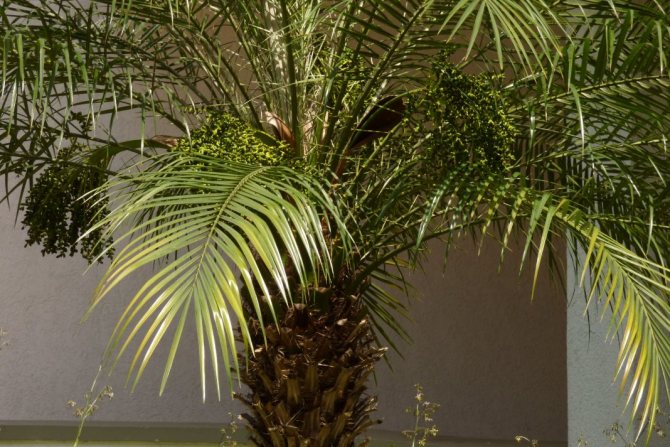

The winter maintenance of a domestic palm tree should be given special attention, since it is in the cold months that the plant is dormant, accumulating strength for future active growth.
"Equatorial" indoor temperatures are the worst thing you can do to a palm tree during rest. The heat provokes drying of the leaves, the culture loses its attractive appearance and subsequently recovers for a long time.
The temperature regime in the room must be maintained depending on the type:
- + 8- + 12 degrees - for washingtonia, trachycarpus and brachea;
- about +24 - for the date of Robelen, hamedorea and areca;
- +16 degrees - for rapeseed, rapalostilis and sabal.
Without airing, the leaves of the palm tree dry at the tips, while drafts harm the crown. Keep the balance - move the pot out of the room when you open the window so that the green mass is not affected by the cold air currents.
Frequent transplants
Improper transplantation is the reason why palm leaves can turn yellow and dry at the tips. It is necessary to transfer the plant to a new pot only after the complete development of the earthen coma, so that the sensitive root system is not injured.
It is necessary to replant young specimens once a year, adult palms - every 2-3 years. Large trees in massive tubs do not touch, but only replace the top layer of soil with a fresh one and feed them regularly.
An unscheduled transplant is justified only if the palm is sick and needs to revive the root system or completely replace the soil.
Similar situations arise with an invasion of pests, the development of root rot and strong waterlogging of the soil in a pot.
Improper watering
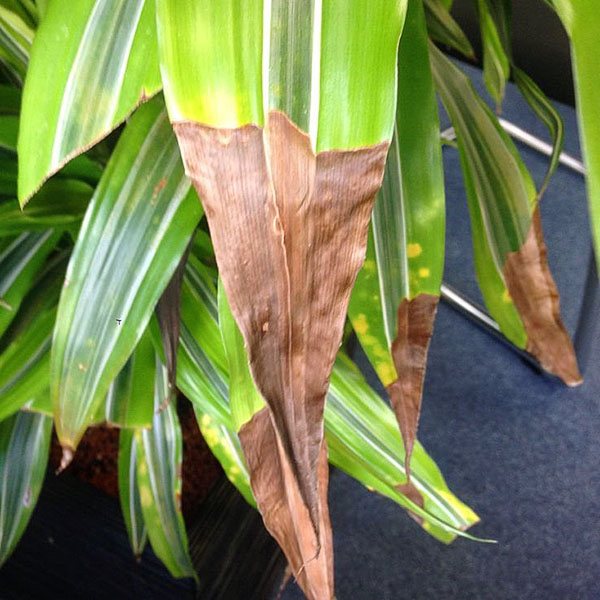

The lack of moisture in the soil inevitably affects the green mass of the palm, causing the tips to dry out. Excessive watering is fraught with similar external consequences, but the root system suffers more in such a situation.
A dried palm tree can be drunk, and a plant affected by waterlogging of the soil requires serious measures.
Simple guidelines will help you avoid watering mistakes:
- Moisten the soil in the pot only after the top layer has dried (2-3 cm).
- Use warm or room temperature water, letting stand for several days until sediment forms and chlorine weathers.
- Drain all the liquid that remains in the pan half an hour after watering.
- Moisten the substrate less frequently in winter than in summer, as moisture evaporates more slowly in cooler conditions.
The house palm needs a good quality drainage system to prevent moisture stagnation around the roots. Make sure that there are special holes at the bottom of the pot, and before each transplant, lay a layer of expanded clay before backfilling the soil.
It is not recommended to water an overdried indoor palm with a "shock" portion of water - this will lead to root breakage and subsequently affect the ability to absorb nutrients. Better to solder the wood gradually, slightly moistening the substrate every couple of hours.
If the palm tree begins to dry its leaves due to strong waterlogging of the soil, it is better to immediately transplant it into fresh, light soil.
Gently remove the plant from the container, remove all waterlogged substrate and inspect the roots, removing all decayed and dead areas.
Places of cuts must be sprinkled with crushed charcoal, which will prevent further spread of rot. After transplanting, moderate watering is recommended, while it is better to keep the palm in light partial shade for 2-3 days.
Mineral starvation: why is feeding important?
Iron, nitrogen, potassium, phosphorus and other trace elements are important components of a nutritious palm tree nutrition. With their deficiency, the state of the green mass deteriorates, the tips dry out, and the plant loses its decorative effect.
To prevent mineral starvation, it is enough to regularly apply special fertilizers for Palm trees or compositions for decorative leafy indoor flowers.
The optimal frequency is 1 time every 10-14 days during the active growing season (from spring to early autumn). Be sure to follow the dosage to avoid overfeeding.
You need to fertilize the palm only in moist soil so that the root system does not suffer from burns.
Pests and diseases
Most often, the palm tree is affected by the scale insect, spider mite and mealybug, which feed on leaves and gradually spread throughout the plant.
Improper care significantly increases the likelihood of infection, since a specimen with a weakened immune system is unable to resist insects.
Insecticides "Fitoverm", "Confidor", "Aktellik" and their analogues show high efficiency in the fight against these pests.
Spraying the crown is carried out with a solution prepared according to the instructions on the package, the optimal number of treatments is 3-4 every 5 days.
In the presence of large colonies of insects, a highly concentrated dose of the drug is used (2-3 times more than the recommended one) and additional soil spillage.
The leaves of the house palm can dry out and turn black as root rot spreads, which first disrupt the nutrition of the plant, and then provoke its complete death.
At the initial stage of the disease, it is possible to save a palm tree with the help of an unscheduled transplant and normalization of agricultural technology.
Maintenance and care
How to humidify the air
Dry indoor air contributes to the fact that the leaves of the palm turn yellow. An unusual way to humidify is to put several pots of plants in the room.
They will release moisture into the surrounding atmosphere, which will give the room an optimal microclimate. Another popular method is to use a household humidifier.
Airing
It is needed all year round for fresh air so that the tips of the leaves do not dry out. At temperatures below 0 ° C, windows and vents should be opened for a short time, but often. The room temperature should be within 20 ° C.
Natural evaporation of moisture
There are several methods:
- put containers of water near the palm tree;
- install an indoor fountain;
- put wet towels on the battery;
- put wet expanded clay or pebbles under the pot.
There are many reasons why a palm tree turns yellow. Some of them are natural; over time, the yellow spots disappear. Other reasons are due to improper care of the plant, requiring certain measures.
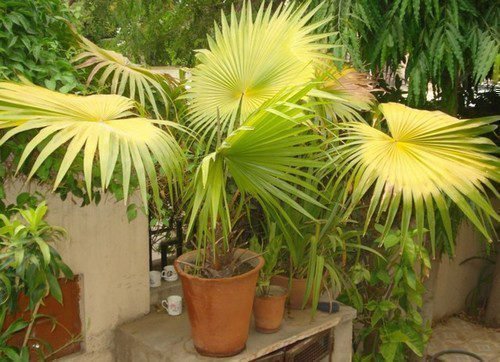

Yellowing of the leaves is a sign of improper care
Palm is an exotic plant from the tropics. In the conditions of a city apartment, the southern flower often does not acclimatize well, it needs to create the right conditions for normal growth and development. Otherwise, the color of the leaves changes, its owners have a question why the leaves of the palm tree turn yellow.
Sometimes palm leaves turn yellow and fall off for a natural reason - the plant gets rid of the old lower leaves. But more often than not, yellow leaves appear for other reasons.
Houseplant owners often wonder why the leaves of the palm tree dry. It often gets hot in apartments in winter due to hot batteries. Such an atmosphere negatively affects green plants; for a palm tree, the interval from 15 to 20 degrees is considered a suitable temperature in winter. Dry air must be humidified, a tropical plant should be sprayed with a spray bottle. The top layer of the soil should be moistened; often, the palm should not be watered.
The opinion that the palm tree can be placed only in the southern part of the room is incorrect. Direct sunlight has a detrimental effect on the plant; it is best to place the pot a little further from the window. In winter, a cold window sill harms the flower, at this time of the year most of the palms dry and wither, their leaves turn yellow, turn black and fall off. Drafts are contraindicated for palm trees.
During airing, it must be covered or taken out of the room. At the same time, the access of fresh air to the palm tree cannot be stopped, otherwise growth will slow down.
One of the answers to the question why the leaves of the room palm turn yellow is the wrong transplant. It is necessary to place a palm tree in a new pot when it is cramped in the old pot, the roots have grown too much. Transplanting a young plant should be done no more than once a year. In some cases, the topsoil can be replaced. The older flower is transplanted about once every three years. The new pot should be taller and wider than the previous one.
Sometimes the question is why the palm tree dries , resolved in an unexpected way - insects, among which the most common are scale insects. These rounded brown insects are from the family of Homoptera, the females have the so-called scutes. Palm scale insects attach to young shoots and suck the juices out of it.
There are several options for substances to combat scale insects:
- soap solution;
- garlic solution;
- alcohol solution;
- chemical preparations - insecticides (actellic is the most effective).
This small insect is difficult to see. In the presence of a tick, the leaves turn yellow and are covered with a small cobweb.
To defeat the spider mite, folk (onion solution) and chemical methods are also used. Before processing, the palm should be thoroughly wiped with a damp cloth.
This is one of the most dangerous insects for the palm tree, it is a large white louse. The plant looks like it is sprinkled with flour, all parts are covered with mucus. The worms attack the flower very quickly, the palm leaves turn yellow.
To save a palm tree from a mealybug, preventive measures are needed. If a disaster occurs, then all the above methods of pest control are effective. You can use citrus zest tincture and olive oil.
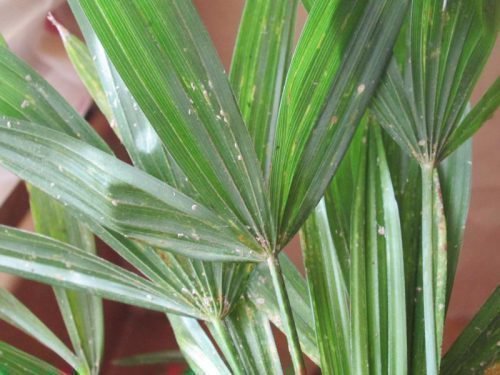

Mealybugs are extremely dangerous for palms
Leaves or their tips may turn black:
- due to the prevalence of dry air in the room and the lack of optimal watering;
- due to excess moisture, access to cold air, caked earth in the pot.
It is enough to eliminate the negative points in order to revive the plant. Additionally, you can try to feed him with fertilizers.
This plant with feathery wide leaves and a dense crown is quite unpretentious in care. It grows best on clay-sod soil. There are about 15 species of date palm, it has solid edible fruits - dates.
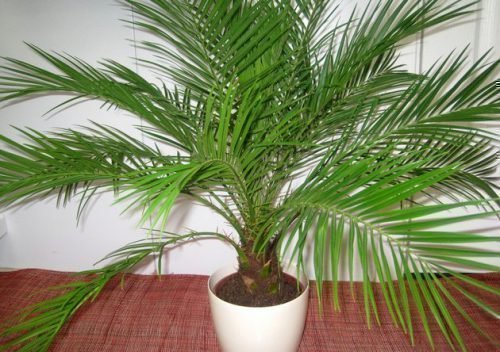

Date palm is an unpretentious plant
It can grow up to 6 meters long, its crown resembles a fan, the leaves are tough. Indoors, you can try to grow a dwarf species. Bright sunlight is useful for a boutique, but high humidity is not, it dries up. In summer, weekly watering is enough, and in winter this can be done even less often. Butea blooms beautifully.
There are about three dozen species of Livistona. At home, it can grow up to 3 meters long, has bright green leaves.
Caring for it does not require much work: it must constantly receive moisture, the temperature in the room should not drop below 20 degrees.
This species is distinguished by narrow, tough leaves. Hamerops is not afraid of direct sunlight, grows slowly, does not need frequent replanting, the soil of the plant should be loose.
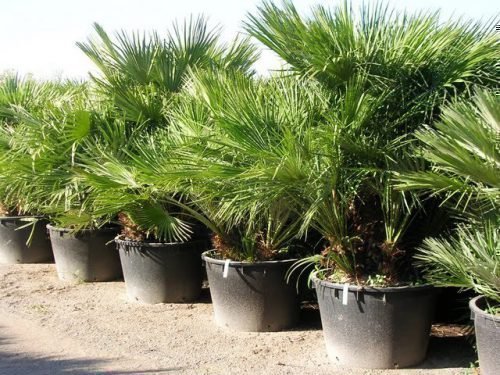

Hamerops is not afraid of the scorching sun
The variety has wide feathery leaves. It does not grow quickly, but it can reach the ceiling. Hovea endures lack of light, moisture, invasion of harmful insects.
This flower needs constant sunlight, it can withstand low temperatures (up to 8 ° C). What you should not do is water Washingtonia abundantly, otherwise the soil will dry out.
The most common type of palm. She needs light almost round the clock, the pot of yucca must be turned so that the rays of the sun fall on her. In the dark, artificial lighting should be used. Watering the yucca depends on the season - it needs less water in winter and autumn. Indoor yucca does not bloom.
This plant is characterized by fan-shaped leaves, it can grow large, or it can remain in a small pot. For successful growth at home, minimal conditions are needed, sabal has a medicinal effect.
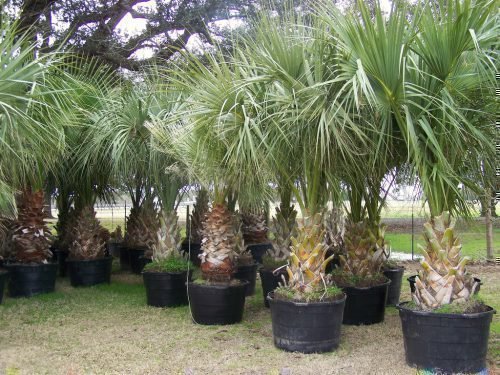

Sabal can grow to impressive sizes
Dry indoor air contributes to the fact that the leaves of the palm turn yellow. An unusual way to humidify is to put several pots of plants in the room.
They will release moisture into the surrounding atmosphere, which will give the room an optimal microclimate. Another popular method is to use a household humidifier.
It is needed all year round for fresh air so that the tips of the leaves do not dry out. At temperatures below 0 ° C, windows and vents should be opened for a short time, but often.The room temperature should be within 20 ° C.
There are several methods:
- put containers of water near the palm tree;
- install an indoor fountain;
- put wet towels on the battery;
- put wet expanded clay or pebbles under the pot.
The date palm is a common home-grown crop. Thanks to the spreading crown and feathery foliage, the plants look spectacular in any room. When growing trees, the question often arises as to why the tips of the leaves of the date palm begin to dry. Having dealt with the cause of the problem, it will be possible to restore the state of the plantings and ensure correct growth.
How to fix problems
Proper watering
The most important condition for the formation of beautiful green leaves in a home palm is proper watering.In addition, the plants need regular spraying. It is imperative to carefully monitor that when watering the earthen lump is sufficiently evenly saturated with moisture. This nuance is revealed by the usual tapping on the pot. If the sound is sonorous, it means that the ground is dry. A dull sound is wet. It is also necessary to pour out excess water from the sump after watering the plant. Water for watering a palm tree must be used settled, and water the plant only after the earth has dried out, checking by tapping on the pot.
Indoor air temperature
It is necessary to monitor the air temperature in the room where the palm tree grows. It would be a mistake to think that the palm tree needs heat in winter. Palm trees, which are native to the tropics, survive the winter in moderately warm conditions, but subtropical beauties need cooler conditions in winter.
For most plants, the optimum temperature in winter is 16 -20 degrees. And do not put the plant in a draft, especially in winter. Plants do not tolerate drafts, especially in winter, they are too sensitive to cold. So that the root system of the palm tree does not suffer, you should not put the plant on the cold marble of the floor or windowsill in winter. Having placed the plant in a safe place, it is nevertheless necessary to provide for the palm tree to receive fresh air, otherwise its growth and development will slow down.
Moisturizing
Air humidification during the heating season is a prerequisite for keeping a home palm. Dry air can greatly harm the plant. The leaves begin to dry, the tips turn yellow quickly, and then gradually die off. Therefore, by all means, during the heating season, plants need to be sprayed and humidified in the apartment. Throwing a gentle shower on your palm tree every morning will give you wonderful results and will also improve the humidity in your home. (It is better to take boiled, settled water for this purpose and pour it into plastic bottles for storage).
You can purchase a special air humidifier, today there are a great many of them on sale, with a variety of functions. They are able to spray water in the room, spray with a fan. It is very convenient to use a hygrometer to determine the humidity in a room. There are even digital versions of hygrometers - thermohygrometers - with an additional indication of air temperature and time. Although there is also a popular method for determining moisture. You just need to put a pine cone in the room. If the room is dry, then the scales on it open, and if it is damp, they close tightly.
Top dressing and transplanting
There are special liquid fertilizers for palms today. In the summer, it is necessary to feed the plant twice a month, and in the winter, once is enough. If the root system has grown, it is necessary to transplant the plant in a timely manner into a pot of a suitable size. But if done incorrectly, the leaves of the palm tree can begin to turn yellow. You cannot transplant a young flower into a new pot more often than once a year. An old palm tree can be replanted every three years. A new plant pot is chosen not only for color.It needs to be slightly taller and wider than the old one. In addition, when cutting off the yellowed tips of yellowed leaves, care must be taken not to cut or damage the green part of the leaf. From this, the sheet will only begin to dry faster and will soon fall off.
Diseases and pests
Sometimes insect pests are the cause of leaf drying on a palm tree. Most often these are scale insects - small brown, rounded insects, and females have small scutes. These insects, sucking on young shoots, suck the juices out of them. As a result, the palm leaves turn yellow and the plant may die. There are many popular ways to kill insects, as well as insecticides that are quite effective.
Another threat is spider mites. This parasite is so small that it is difficult to see it. The leaves affected by the mite turn yellow and are covered with a thin web. Before you start processing the plant, you must thoroughly wipe the leaves with a damp cloth.
The biggest threat to the palm is the mealy worms, in other words, the big white louse. At the same time, the affected plant is as if sprinkled with flour, and the stems are covered with mucus. Parasites attack with lightning speed. The leaves turn yellow and the plant will soon die, unless urgent measures are taken to save it.
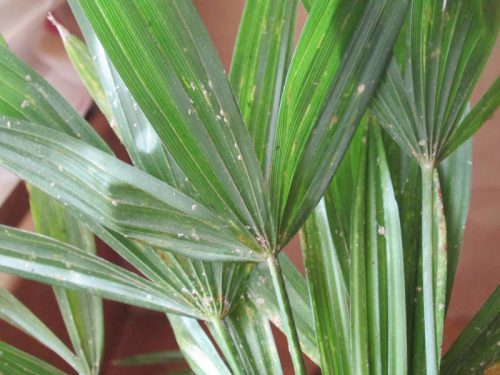

Care and proper care will give you the opportunity to admire the beautiful ornamental plant in your home at any time of the year.
Common causes of yellow foliage
Sometimes palm leaves turn yellow and fall off for a natural reason - the plant gets rid of the old lower leaves. But more often than not, yellow leaves appear for other reasons.
Dry air
Houseplant owners often wonder why the leaves of the palm tree dry. It often becomes hot in apartments in winter due to hot batteries. Such an atmosphere negatively affects green plants; for a palm tree, the interval from 15 to 20 degrees is considered a suitable temperature in winter. Dry air must be humidified, a tropical plant should be sprayed with a spray bottle. The top layer of the soil should be moistened; often, the palm should not be watered.
Draft
The opinion that the palm tree can be placed only in the southern part of the room is incorrect. Direct sunlight has a detrimental effect on the plant; it is best to place the pot a little further from the window. In winter, a cold window sill harms the flower, at this time of the year most of the palms dry and wither, their leaves turn yellow, turn black and fall off. Drafts are contraindicated for palm trees.
During airing, it must be covered or taken out of the room. At the same time, the access of fresh air to the palm tree cannot be stopped, otherwise growth will slow down.
Frequent replanting
One of the answers to the question why the leaves of the room palm turn yellow is the wrong transplant. It is necessary to place a palm tree in a new pot when it is cramped in the old pot, the roots have grown too much. Transplanting a young plant should be done no more than once a year. In some cases, the topsoil can be replaced. The older flower is transplanted about once every three years. The new pot should be taller and wider than the previous one.
Why do palm leaves dry?
2 posts
Many growers are wondering. "Why do the leaves of the palm tree dry?" Let's try to figure it out.
Drying of the tips of the leaves in palm trees most often occurs from too dry air, insufficient watering. And they die entirely, if very old, from root decay during overflows or from damage by various pests and pathogens.
The yellowed tips of the leaves should be cut off. However, this should be done without touching the living green tissue of the leaf and leaving a thin strip of dry tissue, otherwise drying will go further even faster, and the leaf can be lost. Only completely dry leaves are removed, otherwise others will begin to dry.
Much depends on what light and temperature conditions your plants are in, how you care for them, because some fan palms need coolness in winter. * Palms of warm rooms - areca, coconut, cariota, hamedorea, acanthophenix, robelini phoenix - require high room temperature and humidity. * Palms of temperate rooms - hovei (Belmora, Forster), Bonneti coconut, geonoma, clinostigma, rapalostilis, rapese, sabal, etc. * Palms of cool rooms - hamerops, brachea, washingtonia, trachycarpus, etc.
In indoor conditions, palms need regular spraying, proper watering, in which the earthen ball should be evenly moistened, which is determined by tapping the pot with clicks from the bottom up. A dull sound appears if the soil is wet, harsh when it is dry. After watering, water should be poured into the pan, which will be absorbed into the ground within an hour. It must be drained or removed with a clean cloth. It should be watered with settled water after the soil dries out from above in the pot.
Palm trees of tropical origin require the maintenance of moderately warm or warm rooms in winter. Palms, which are native to the subtropics, are best kept in cool rooms in winter. All palms do not tolerate drafts well, especially you need to be wary of cold air when ventilating a room in winter through a window. The roots of palm trees are very sensitive to cold, so palm pots should not be placed on a cold windowsill or marble floor slabs.
Popular types
Date palm
This plant with feathery wide leaves and a dense crown is quite unpretentious in care. It grows best on clay-sod soil. There are about 15 species of date palm, it has solid edible fruits - dates.
Date palm is an unpretentious plant
Butea
It can grow up to 6 meters long, its crown resembles a fan, the leaves are tough. Indoors, you can try to grow a dwarf species. Bright sunlight is useful for a boutique, but high humidity is not, it dries up. In summer, weekly watering is enough, and in winter this can be done even less often. Butea blooms beautifully.
Livistona
There are about three dozen species of Livistona. At home, it can grow up to 3 meters long, has bright green leaves.
Caring for it does not require much work: it must constantly receive moisture, the temperature in the room should not drop below 20 degrees.
Hamerops
This species is distinguished by narrow, tough leaves. Hamerops is not afraid of direct sunlight, grows slowly, does not need frequent transplanting, the soil of the plant should be loose.
Hamerops is not afraid of the scorching sun
Hovea
The variety has wide feathery leaves. It does not grow quickly, but it can reach the ceiling. Hovea endures lack of light, moisture, invasion of harmful insects.
Washingtonia
This flower needs constant sunlight, it can withstand low temperatures (up to 8 ° C). What you should not do is water Washingtonia abundantly, otherwise the soil will dry out.
The most common type of palm. She needs light almost round the clock, the yucca pot must be turned so that the sun's rays fall on her. In the dark, artificial lighting should be used. Watering the yucca depends on the season - it needs less water in winter and autumn. Indoor yucca does not bloom.
Sabal
This plant is characterized by fan-shaped leaves, it can grow large, or it can remain in a small pot. For successful growth at home, minimal conditions are needed, sabal has a medicinal effect.
Sabal can grow to impressive sizes
Why does the date palm dry?
There are many reasons why palm leaves dry up and begin to turn yellow.Most often, the problem occurs as a result of improper care, violation of disembarkation rules or adverse environmental conditions. The plant may develop poorly due to non-observance of the heat, humidity and lighting regime..
Air humidity
Drying of the tips of the leaves and the acquisition of a brownish tint indicates inappropriate humidity. Including, the following problems may be observed:
- too dry air;
- through blowing;
- sharp temperature drop.
It is important to consider that in a plant that has been growing for several years, due to natural processes, the leaves in the lower part of the palm gradually begin to turn yellow, dry and die off. Drying can also begin during hot dry summers.
Soil moisture
Excessive introduction of liquid into the soil leads to the fact that the trunk of the palm tree becomes soft, rotting and exudes an unpleasant odor. At the same time, the leaves of the date palm begin to darken and dry. Insufficient moisture also provokes abnormal development of the green part of plants.
When faced with a problem, it is necessary to do moderate watering or temporarily suspend the moisture if necessary to allow the soil to dry out. If possible, remove the palm from the pot and examine the roots for signs of decay. If the roots have acquired a dark shade, become soft and watery, then the chances of plant recovery will be minimal. The damaged parts of the roots are pruned, allowed to dry and treated with a growth stimulant.
Pests
The attack of harmful insects leads to abnormal development and deterioration of the appearance of plants. If pests infest a houseplant, it is necessary to establish their variety in order to begin an appropriate fight. The following parasites are dangerous for the date palm:
- Shield. The insect absorbs the sap from the palm, leaving brown discoloration on the leaves. In the future, the foliage becomes yellow, dries up and falls off.
- Red spider mite. The parasite occurs on a tree due to a violation of the temperature and humidity regimes. The mite damages the stem and leaves, leaving gray and yellow plaques.
- Thrips. You can detect the attack of thrips by the brown spots on the back of the leaf. Pests lay eggs on the foliage and lead to drying out of the ground part.
- Common spider mite. A sign of the appearance of an insect is the formation of a web on the leaves. The pest is especially active in excessively dry air.
- Mealybug. The parasite is capable of infecting the branches and crown of the date palm. Due to the influence of the worm, the foliage quickly dries up and crumbles.
Diseases
The most common date palm disease is gray spot. The characteristic signs of the disease are darkening of the gray color on the surface of the leaf plates. Mostly spots appear on old leaves. If you do not take measures to combat the disease, due to the development of spotting, black blotches will begin to form, which represent the spores of the fungus.
In order to treat the disease, you will need to carefully cut off all infected parts to prevent the spread of the infection. Then carry out the treatment with fungicidal antifungal drugs.
Also, the plant is characterized by the appearance of root rot due to excessive moisture in the soil. With the development of the disease, the leaves turn yellow, and then gradually darken and die off. The spread of rot is accelerated with abundant watering, severe temperature changes and a lack of nutrients in the soil. Root rot treatment is possible only at the initial stage of development. The plant is pruned the affected roots and soaked in a solution of a suspension of fungicides. The soil from the pot is steamed and disinfected.
Black dots on the plant
Black dots on the leaves are an alarming symptom for plant owners.Blackening of the leaves occurs when there is excessive temperature in the room and insufficient watering of the flower. If the palm tree is not moved to a cool place in time and the watering is not increased, the plant will die.
The second reason for the appearance of blackness on the leaves is the other extreme. Many owners literally fill in the flower and put the hovea in a cool place in a draft.
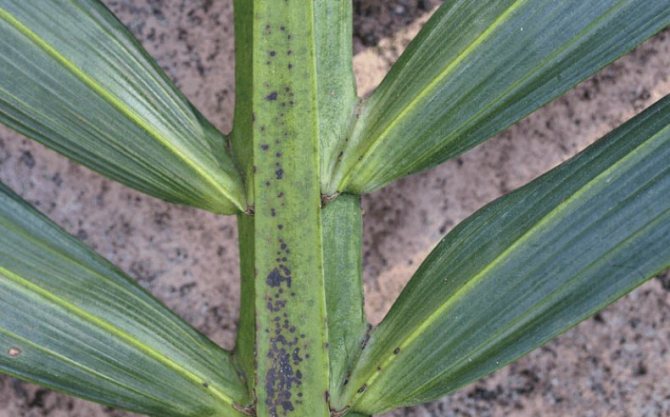

The result is one: blackening of individual leaves, then the entire crown, which will lead to the death of the plant.
To avoid this, it is necessary to provide a stationary temperature 20 to 24 degrees Celsius and humidity 60–65%.
What to do with this problem?
Having discovered the abnormal development of the date palm and drying out of the foliage, it is necessary to establish the cause of the problem. If the leaves of the tree turn yellow and dry due to improper care, it is enough to follow the recommended watering regime, equip the drainage system, apply fertilizers and remove the dying parts of the plant. A favorable environment should also be provided, including bright lighting, humid air, room temperature and no blowing.
If the cause of the disease is an invasion of parasites, protective treatment will be required. For this:
- moisten a sponge in a soapy solution and gently wipe the leaves;
- the plant is sprayed with a biological product selected to combat a specific pest;
- repeat the treatment with an interval of 5-7 days until the complete destruction of the parasites.
To fight diseases of the date palm, fungicidal preparations are used. You can also use the folk method and do rubbing the affected areas with medical alcohol.
Diseases and pests
Shields
Sometimes the question is why the palm tree dries , resolved in an unexpected way - insects, among which the most common are scale insects. These are rounded brown insects from the family of Homoptera, the females have the so-called scutes. Palm scale insects attach to young shoots and suck the juices out of them.
There are several options for substances to combat scale insects:
- soap solution;
- garlic solution;
- alcohol solution;
- chemical preparations - insecticides (actellic is the most effective).
Spider mite
This small insect is difficult to see. In the presence of a tick, the leaves turn yellow and are covered with a small cobweb.
To defeat the spider mite, folk (onion solution) and chemical methods are also used. Before processing, wipe the palm thoroughly with a damp cloth.
Mealybugs
This is one of the most dangerous insects for the palm tree, it is a large white louse. The plant looks like it is sprinkled with flour, all parts are covered with mucus. The worms attack the flower very quickly, the palm leaves turn yellow.
To save a palm tree from a mealybug, preventive measures are needed. If a disaster occurs, then all the above methods of pest control are effective. You can use citrus zest tincture and olive oil.
Mealybugs are extremely dangerous for palms
Why do palm leaves dry?
Many growers are wondering. "Why do the leaves of the palm tree dry?" Let's try to figure it out. In short, the drying of the tips of the leaves of palm trees most often occurs from too dry air, insufficient watering. And they die entirely, if very old, from root decay during overflows or from damage by various pests and pathogens.
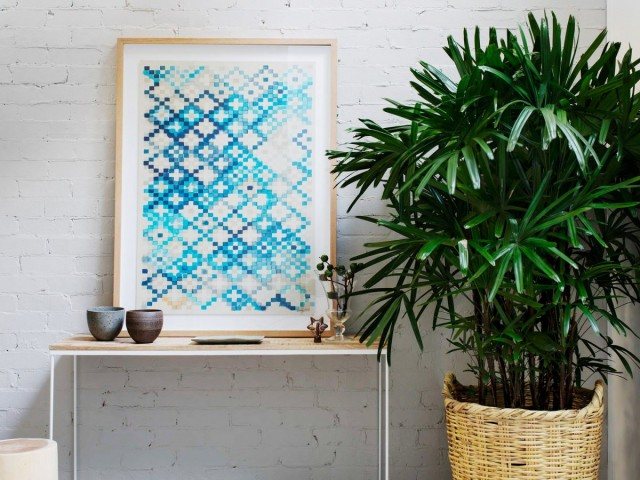

Rapeseed in a pot. <>
Much depends on what light and temperature conditions your plants are in, how you care for them, because some fan palms need coolness in winter.
- The palms of warm rooms - areca, coconut, cariota, chamedorea, acanthophenix, Robelini phoenix - require a high room temperature and humidity.
- Palm trees of temperate rooms - hovei (Belmora, Forster), Bonneti coconut, geonoma, clinostigma, rapalostilis, rapis, sabal, etc.
- Palms of cool rooms - hamerops, brachea, washingtonia, trachycarpus, etc.
In indoor conditions, palms need regular spraying, proper watering, in which the earthen ball should be evenly moistened, which is determined by tapping the pot with clicks from the bottom up. A dull sound appears if the soil is wet, harsh when it is dry. After watering, water should be poured into the pan, which will be absorbed into the ground within an hour. It must be drained or removed with a clean cloth. It should be watered with settled water after the soil dries out from above in the pot.
Palm trees of tropical origin require the maintenance of moderately warm or warm rooms in winter. Palms, which are native to the subtropics, are best kept in cool rooms in winter. All palms do not tolerate drafts well, especially you need to be wary of cold air when ventilating a room in winter through a window. The roots of palm trees are very sensitive to cold, so palm pots should not be placed on a cold windowsill or marble floor slabs.
Plants need regular (twice a month in summer and once in winter) feeding with a special liquid fertilizer for palms. Examine the bottom of your palms' flowerpots to see if their roots have come out and are pushing the soil out of the pot from above? Then they need to be transplanted into larger planters with fresh soil mixture, recommended especially for palm trees.
The yellowed tips of the leaves should be cut off. However, this should be done without touching the living green tissue of the leaf and leaving a thin strip of dry tissue, otherwise drying will go further even faster, and the leaf can be lost. Only completely dry leaves are removed, otherwise others will begin to dry.
Palm Licuala large (Licuala grandis).
Blackening of the foliage
The tips of the leaves may turn black. The causes of this problem are most often in the conditions in which the indoor palm is kept.
To date, the following factors are known that cause blackening of the foliage in palm plants:
- Dry air prevails in the room.
- The palm is not properly watered.
- Influence of cold air currents.
- Caked earthen lump.
To help the plant, you do not need to do anything special, it is enough to eliminate the cause of the problem. Florists recommend applying fertilizing with fertilizers.
If you had to think about the question of why the leaves of the palm tree are drying, or other unhealthy metamorphoses are observed, then you should think about whether the basic recommendations for plant maintenance have not been violated. Knowing how to properly care for a palm tree can avoid the need to save it from leaf problems and possible death.
In order not to puzzle over why the palm tree dries, you should not overlook the following points:
- Maintain optimal air humidity.
- Ventilate the room containing the palm tree.
- Providing a natural process for moisture evaporation.
Keeping in mind that palm leaves turn yellow mostly due to violations of optimal conditions, many problems can be avoided. Adhering to elementary rules, a florist can rejoice for a long time that a healthy and beautiful palm tree grows in his house.
A few tips on how to humidify dry air
Airing
On a frosty day, do not open the windows wide in a room with plants. Also note that frosty air is dry in most cases. Therefore, ventilation does not increase the humidity in the room. It is best to ventilate more often, but little by little.
Advice: At a temperature of about 0 ° C, it is enough to open the windows for 10 minutes every 2-3 hours.
Optimum temperatures: 20 ° C in the living room, 16-18 ° C in the kitchen and bedroom.
Advice: If possible, control the temperature in the house, not by ventilation, but with a thermostat.
Natural evaporation of moisture
Hang wet towels on the radiators or place bowls and other open containers filled with water next to them. Tropical aquatic plants in miniature vases and bowls will additionally humidify the air.
Advice: Wash glass vases frequently to prevent algae from growing on the walls.
An indoor fountain is more than just a decorative piece of furniture. The sound of gently splashing water soothes the nervous system and relieves stress. At the same time, moving, slowly evaporating water has a positive effect on the state of the air. The smallest dust particles are moistened, become heavier and gradually sink to the floor.
Advice: Fountains with containers for planting plants are on sale. You can add essential oil to the water for the fountain.
Treat plants that need high air humidity, such as arrowroot, to please: put it on constantly moistened expanded clay or small pebbles. The evaporated moisture will rise directly to the leaves.
Advice: Place a water level indicator in the planter, then the roots will not suffer from dampness, and the aboveground part of the plant will not suffer from dryness.
Green humidifiers
Cyperus is unrivaled among indoor plants: depending on its size, it releases from 500 ml to 2 liters of moisture per day into the air. For such records, place a bowl filled with water next to it and spray its leaves daily.
Advice: Better yet, put several plants side by side.
Delicate, like velvet, light green leaves of indoor sticky, or sparmannia, which grows to the ceiling in suitable conditions, evaporate moisture all year round. Spray the sparmania daily from above and below with settled water. Water very sparingly in winter, making sure the plant needs watering.
Advice: Be careful if you have allergies. In this case, try not to touch the sparmannia leaves.
Electric humidifier
There are a variety of models on sale with a wide range of prices. They vaporize, spray and spray moisture or distribute it evenly throughout the room by ventilation.
Spraying plants
In a heated room, spray the leaves of green plants every morning. It doesn't take long, but it brings wonderful results. A gentle shower refreshes the plants, allowing their cells to work at full strength, and in addition increases the humidity in the room.
Advice: For spraying, boil water in a large saucepan and reserve in large plastic bottles.
Beautiful Hovea fills with energy! Features of caring for a palm tree at home
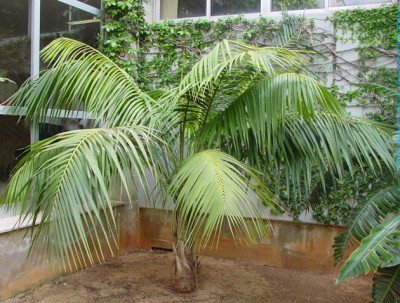

The most beautiful feathery palm tree Hovea has become popular for indoor cultivation (undemanding to care, shade-tolerant).
It grows in nature on the Australian coast and on about. Lord Howe. From the name of the capital of the island, the palm got the name Kentia.
Further in the article we will talk about the Hovea palm: home care, photos, species, diseases and pests.
This kind of palm includes only two types:
- Forsteror Forsteriana - the trunk is straight, the palm is quite high (up to 15 m), the leaves are feathery, slightly curved with dark green wide leaf plates;
Hoveya Forster: photo of this species.
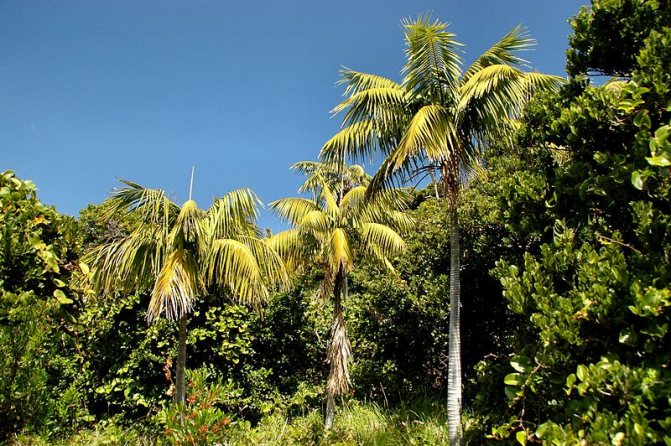

Hovea Belmora - reminds Forster, only with more curved leaves. On the green stems and feathery leaves, you can see woolly hairs located along the edge. Leaves are complex, composed of narrow, smaller ones. Differs in slow growth, when creating favorable conditions in the room, it can grow to the ceiling.
Palm of Hovei Belmora: photo of a plant in nature.
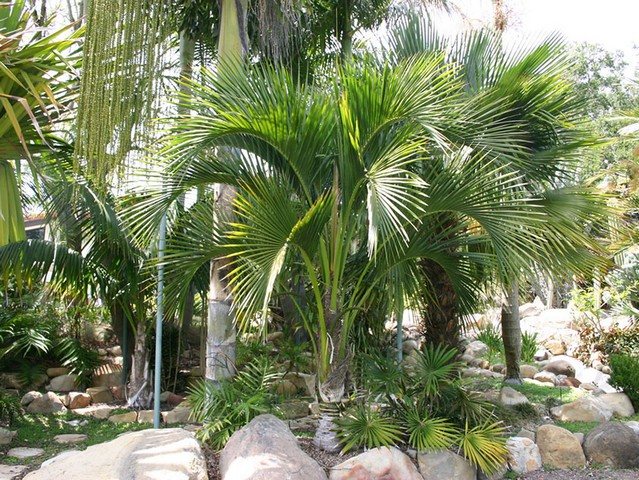

Hovea: photo in the apartment.
